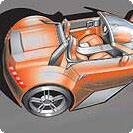
Occupation/Profession: Concept artist and designer
Employer: Daimler-Chrysler and freelance
Corel Painter Master - Christopher Welch
 |
Name: Christopher Welch Occupation/Profession: Concept artist and designer Employer: Daimler-Chrysler and freelance |
Christopher Welch was born and raised in the suburbs of Chicago. At an early age, he accompanied his father to his design studio, where Christopher learned to appreciate the fine smells of markers, Bondo and fiberglass resin. He learned a lot from his father, who still works as an industrial designer in Pennsylvania. After attending the University of Cincinnati, he began working at Magna, a Canadian-based automotive supply company, which was later renamed Intier Automotive.
Christopher worked there as a primary designer in the company's "Advanced" Studio. Recently, he began working at DaimlerChrysler, creating automotive interiors and exteriors. Christopher also does freelance work for the toy and entertainment industry, and he considers himself a hard-core concept designer as well as an automotive design professional.
For more information: www.concept-nucleus.com
Says Christopher Welch:
Concept – a vivid mental image
Vehicle - a vessel that travels over great distances or performs unique tasks
Design - the effort to create beautiful things that are intuitively functional
When you combine these three basic ideas, along with Corel® Painter™ IX, you can create something new, different and exciting for a concept vehicle. Let's explore a basic strategy for developing a concept vehicle based on your imagination.
 Before you set out to create your personal concept vehicle, think about what you want. Think about everything you have ever liked about a car, motorcycle, tank or any other motorized vehicle. Then imagine what it would be like to walk up to your dream car, open the door and look at the seats and the interior. Continue by envisioning the steering wheel, the operating controls and the engine. What type of car is it you envision? What is its purpose? Are you speeding down the Autobahn? Are you jumping across desert dunes at top speed? Are you flying through the air?
Before you set out to create your personal concept vehicle, think about what you want. Think about everything you have ever liked about a car, motorcycle, tank or any other motorized vehicle. Then imagine what it would be like to walk up to your dream car, open the door and look at the seats and the interior. Continue by envisioning the steering wheel, the operating controls and the engine. What type of car is it you envision? What is its purpose? Are you speeding down the Autobahn? Are you jumping across desert dunes at top speed? Are you flying through the air?
Spend the time determining a set of parameters by which you will limit yourself. Then, when you are ready, begin to create a definition of what you are going to design. This concept stage is very important and can be done in your head or on paper.